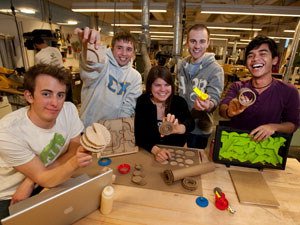Prototype. Test. Repeat.

3D tools speed creative teamwork
Five students, five majors, one team--they are the "purple" team in a recent toy product design class.
Andy Carlson's field is mechanical engineering. Mac Cameron's is physics. Claire Rydeen is in biomedical engineering to create medical devices. Arya Adiartha works in sustainable design. And Matt Munson aims to become an architect.
A big reason they all took the class was the prototyping, a key design practice that's becoming ever more efficient thanks to the 3D printers and laser cutters and other new tools in the Digital Fabrication Lab.
Benefits of protoyping
Andy: When designing a new product, it is important to make models to see how it will work and what it might look like. These "prototypes" don't always resemble the finished product. However, they allow us to find problems and make the product better before it's put in the store.
Claire: What you visualize in your mind can materialize much differently. And being able to hold and move and see the actual object forces you to improve and build upon your original idea.
Matt: Prototyping allows my ideas to materialize into physical things, often with limitations and challenges. Prototypes are a useful way of communicating ideas in more depth because the group then has a model to discuss.
3D tools help
Andy: The 3D printer allows us to quickly and cheaply make a physical model with all the detail and complexity of the final form. These "printed" parts can even be functional to see how an idea will work.
Mac: 3D printers allow pretty much any customized plastic piece to be just a-drawing-and-a-click away. This allows us to build and actually test pieces so they fit correctly. Ideas cannot be stopped by imprecise cuts or lack of skills on machinery anymore.
Claire: If I think of something that requires circles, normally I'd be tracing circles on a cup and cutting them out with an Xacto knife. Now I can use a laser cutter, which cuts out extremely fine, perfect circles that show exactly what I had in mind.
Arya: You have to consider a lot of things before 3D printing, such as how to position or print the item to ensure the least amount of material is used. It makes you think more practically and efficiently in designing things.
Prototyping in their future
Claire: Prototyping is huge in the medical device industry. Being able to create physical prototypes allows engineers to convey their idea to physicians to see what human factors need to be considered when designing the device.
Andy: Most large companies now own their own 3D printers and use them to demonstrate concepts or convey ideas. Physical prototypes are always more impressive than digital renderings and can influence a client's or manager's opinion of new ideas which could make or break the product.
